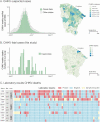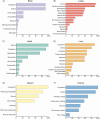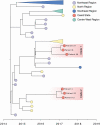Fatal Outcome of Chikungunya Virus Infection in Brazil
- PMID: 32766829
- PMCID: PMC8492446
- DOI: 10.1093/cid/ciaa1038
Fatal Outcome of Chikungunya Virus Infection in Brazil
Abstract
Background: Chikungunya virus (CHIKV) emerged in the Americas in 2013 and has caused approximately 2.1 million cases and >600 deaths. A retrospective investigation was undertaken to describe clinical, epidemiological, and viral genomic features associated with deaths caused by CHIKV in Ceará state, northeast Brazil.
Methods: Sera, cerebrospinal fluid (CSF), and tissue samples from 100 fatal cases with suspected arbovirus infection were tested for CHIKV, dengue virus (DENV), and Zika virus (ZIKV). Clinical, epidemiological, and death reports were obtained for patients with confirmed CHIKV infection. Logistic regression analysis was undertaken to identify independent factors associated with risk of death during CHIKV infection. Phylogenetic analysis was conducted using whole genomes from a subset of cases.
Results: Sixty-eight fatal cases had CHIKV infection confirmed by reverse-transcription quantitative polymerase chain reaction (52.9%), viral antigen (41.1%), and/or specific immunoglobulin M (63.2%). Co-detection of CHIKV with DENV was found in 22% of fatal cases, ZIKV in 2.9%, and DENV and ZIKV in 1.5%. A total of 39 CHIKV deaths presented with neurological signs and symptoms, and CHIKV-RNA was found in the CSF of 92.3% of these patients. Fatal outcomes were associated with irreversible multiple organ dysfunction syndrome. Patients with diabetes appear to die at a higher frequency during the subacute phase. Genetic analysis showed circulation of 2 CHIKV East-Central-South African (ECSA) lineages in Ceará and revealed no unique virus genomic mutation associated with fatal outcome.
Conclusions: The investigation of the largest cross-sectional cohort of CHIKV deaths to date reveals that CHIKV-ECSA strains can cause death in individuals from both risk and nonrisk groups, including young adults.
Keywords: Alphavirus; arthritogenic; arbovirus; chikungunya virus; fatal cases.
© The Author(s) 2020. Published by Oxford University Press for the Infectious Diseases Society of America.
Figures




References
-
- Chen R, Mukhopadhyay S, Merits A, et al. ICTV virus taxonomy profile: Togaviridae. J Gen Virol 2018; 99:761–2. - PubMed
-
- Weaver SC, Lecuit M. Chikungunya virus and the global spread of a mosquito-borne disease. N Engl J Med 2015; 372:1231–9. - PubMed
-
- Queyriaux B, Simon F, Grandadam M, Michel R, Tolou H, Boutin JP. Clinical burden of chikungunya virus infection. Lancet Infect Dis 2008; 8:2–3. - PubMed
-
- Ministério da Saúde, Departamento de Vigilância das Doenças Transmissíveis , Brasil. Chikungunya: manejo clínico. Brasília: Ministério da Saúde, 2017:65p.
Publication types
MeSH terms
Grants and funding
- 302584/2015-3/Brazilian National Council for Scientific and Technological Development
- 204311/Z/16/Z/Wellcome Trust and Royal Society Sir Henry Dale Fellowship
- Fundação Cearense de Apoio ao Desenvolvimento Científico e Tecnológico
- MR/S019510/1/MRC_/Medical Research Council/United Kingdom
- 2017/13981-0/São Paulo Research Foundation
LinkOut - more resources
Full Text Sources
Other Literature Sources
Medical
Molecular Biology Databases

